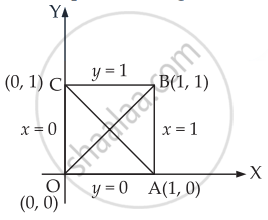Advertisements
Advertisements
प्रश्न
Equations of diagonals of the square formed by the lines x = 0, y = 0, x = 1 and y = 1 are ______.
पर्याय
y = x, y + x = 1
y = x, x + y = 2
2y = x, y + x = `1/3`
y = 2x, y + 2x = 1
उत्तर
Equations of diagonals of the square formed by the lines x = 0, y = 0, x = 1 and y = 1 are y = x, y + x = 1.
Explanation:

Given equation x = 0, y = 0
x = 1 and y = 1 form a square of side 1 unit
From figure, we get that OABC is square having corners O(0, 0), A(1, 0), B(1, 1) and C(0, 1)
Equation of diagonal AC
y – 0 = `(1 - 0)/(0 - 1) (x - 1)`
⇒ y = – (x – 1)
⇒ y = – x + 1
⇒ y + x = 1
Equation of diagonal OB is y – 0 = `(1 - 0)/(1 - 0) (x - 0)`
⇒ y = x
APPEARS IN
संबंधित प्रश्न
Draw a quadrilateral in the Cartesian plane, whose vertices are (–4, 5), (0, 7), (5, –5) and (–4, –2). Also, find its area.
Without using distance formula, show that points (–2, –1), (4, 0), (3, 3) and (–3, 2) are vertices of a parallelogram.
Find the angle between the x-axis and the line joining the points (3, –1) and (4, –2).
Find the slope of the lines which make the following angle with the positive direction of x-axis:
\[\frac{2\pi}{3}\]
Find the slope of the lines which make the following angle with the positive direction of x-axis: \[\frac{\pi}{3}\]
Find the slope of a line passing through the following point:
(−3, 2) and (1, 4)
State whether the two lines in each of the following is parallel, perpendicular or neither.
Through (6, 3) and (1, 1); through (−2, 5) and (2, −5)
Show that the line joining (2, −3) and (−5, 1) is parallel to the line joining (7, −1) and (0, 3).
Prove that the points (−4, −1), (−2, −4), (4, 0) and (2, 3) are the vertices of a rectangle.
Line through the points (−2, 6) and (4, 8) is perpendicular to the line through the points (8, 12) and (x, 24). Find the value of x.
Find the value of x for which the points (x, −1), (2, 1) and (4, 5) are collinear.
By using the concept of slope, show that the points (−2, −1), (4, 0), (3, 3) and (−3, 2) are the vertices of a parallelogram.
Find the equation of a straight line with slope − 1/3 and y-intercept − 4.
Find the equation of a straight line with slope −2 and intersecting the x-axis at a distance of 3 units to the left of origin.
Find the angles between the following pair of straight lines:
3x + y + 12 = 0 and x + 2y − 1 = 0
Find the angles between the following pair of straight lines:
x − 4y = 3 and 6x − y = 11
Show that the tangent of an angle between the lines \[\frac{x}{a} + \frac{y}{b} = 1 \text { and } \frac{x}{a} - \frac{y}{b} = 1\text { is } \frac{2ab}{a^2 - b^2}\].
The acute angle between the medians drawn from the acute angles of a right angled isosceles triangle is
If x + y = k is normal to y2 = 12x, then k is ______.
A ray of light coming from the point (1, 2) is reflected at a point A on the x-axis and then passes through the point (5, 3). Find the coordinates of the point A.
Show that the tangent of an angle between the lines `x/a + y/b` = 1 and `x/a - y/b` = 1 is `(2ab)/(a^2 - b^2)`
If the equation of the base of an equilateral triangle is x + y = 2 and the vertex is (2, – 1), then find the length of the side of the triangle.
A variable line passes through a fixed point P. The algebraic sum of the perpendiculars drawn from the points (2, 0), (0, 2) and (1, 1) on the line is zero. Find the coordinates of the point P.
P1, P2 are points on either of the two lines `- sqrt(3) |x|` = 2 at a distance of 5 units from their point of intersection. Find the coordinates of the foot of perpendiculars drawn from P1, P2 on the bisector of the angle between the given lines.
Slope of a line which cuts off intercepts of equal lengths on the axes is ______.
The tangent of angle between the lines whose intercepts on the axes are a, – b and b, – a, respectively, is ______.
If the vertices of a triangle have integral coordinates, then the triangle can not be equilateral.
The line which passes through the origin and intersect the two lines `(x - 1)/2 = (y + 3)/4 = (z - 5)/3, (x - 4)/2 = (y + 3)/3 = (z - 14)/4`, is ______.
